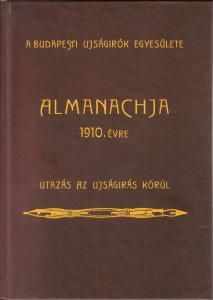
Almanac of the Budapest Journalists’ Association 1910
A Budapesti Ujságirók Egyesülete Almanachja 1910. évre. Utazás az újságírás körül (Almanac of the Budapest Journalists’ Association 1910. A Journey Around Journalism)
Facsimile edition
Accompanying studies written by Zoltán Szénási and Beatrix Visy
NSZL–Argumentum, Budapest, 2017, 376 pages
ISSN 0201-2510
The Almanac of 1910 was subtitled Utazás az újságírás körül (A Journey Around Journalism), and its varied genre and tone explored the relationship between fiction and journalism, the journalistic activities of (fiction) writers, and the tension between the two roles and the two textual worlds. This problem, which can now be referred to the field of sociology of literature and social history, is discussed in Zoltán Ambrus's introductory essay on the journalists and editors of the period (Jenő Rákosi, Zsigmond Singer, Miksa Márkus, Mór Gelléri, Sámuel Radó and others), and in the short prose works of fiction writers (Lajos Biró, Jenő Heltai, Ferenc Herczeg, Ede Kabos, Ferenc Molnár, Gyula Szini, Zoltán Ambrus), recalling the most interesting events of their careers, giving approach to the subject that is enjoyable and accessible to the wider public. The popular image of journalists is also enriched by the satirical and humorous writings of Vulpes's (Izidor Kálnoki) entitled Újságíró-iskola (School of Journalism). The yarbook also commemorates two significant events in the history of literature, the 40th anniversary of Kálmán Mikszáth's literary career and the death of István Petelei.
The Almanacs of the Association of Journalists of Budapest are invaluable repositories for today's researchers on the writers' and journalists' society and its operation of the turn of the century. With the republishing of these, the National Széchényi Library and Argumentum Publisher intend to contribute primarily to the research of the history of society, press and literature at the beginning of the 20th century, but we hope that the volume will be of interest to the ‘educated readership’. Zoltán Szénási's study will provide information of the series as a whole and its history, and Beatrix Visy's study discusses the thematic yearbook of 1910.
Shopping
Our publications are available in our bookshop, or can be ordered from the Publications Department of the NSZL using the contact details below: Főigazgatói Kabinet kiadványtára, Országos Széchényi Könyvtár, 1276 Budapest P.O. box 1205., phone: 06-1-23-23-506, e-mail: kiadvanytar@oszk.hu.




